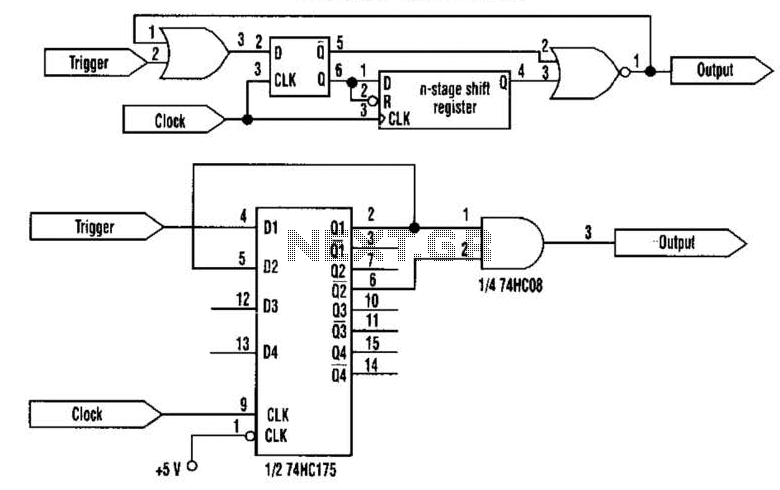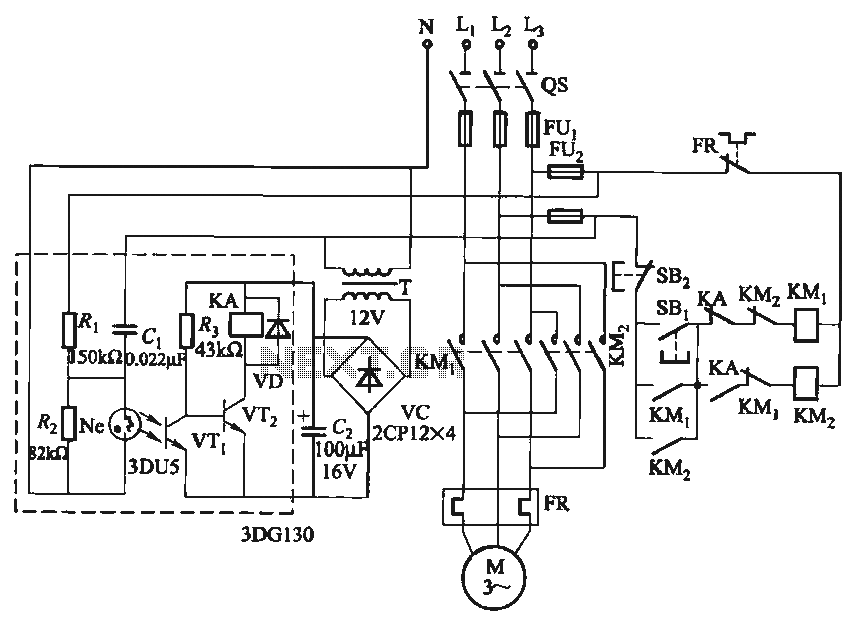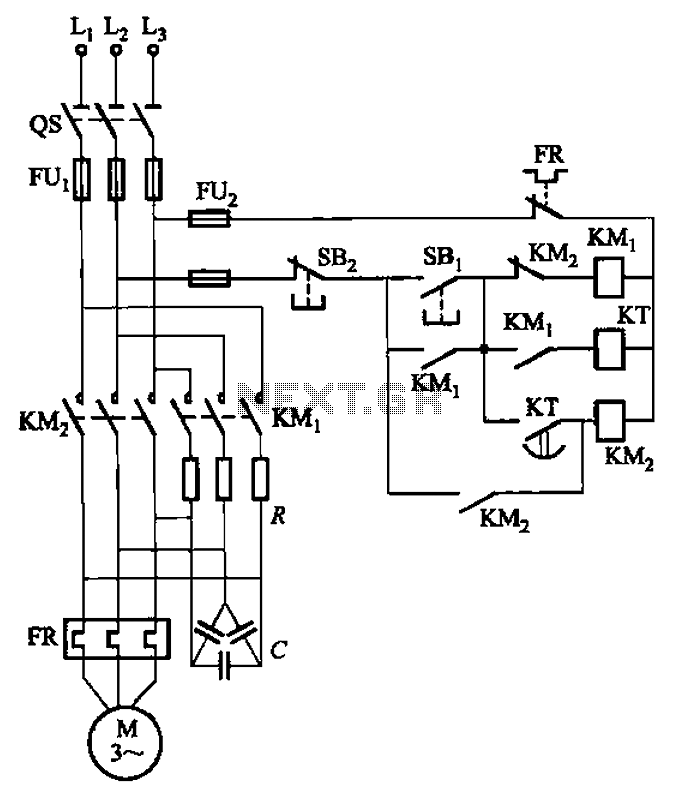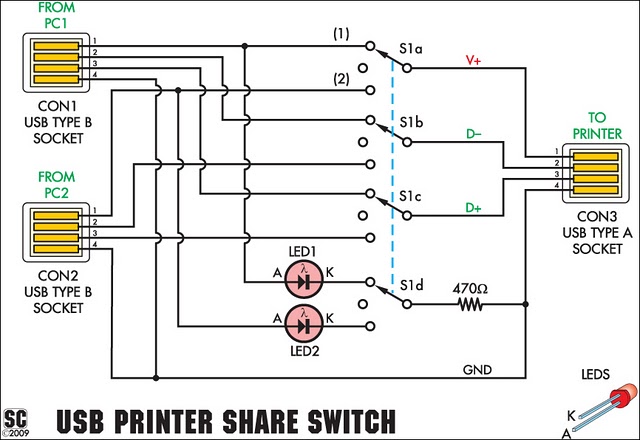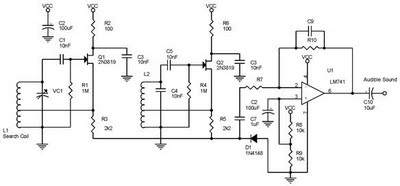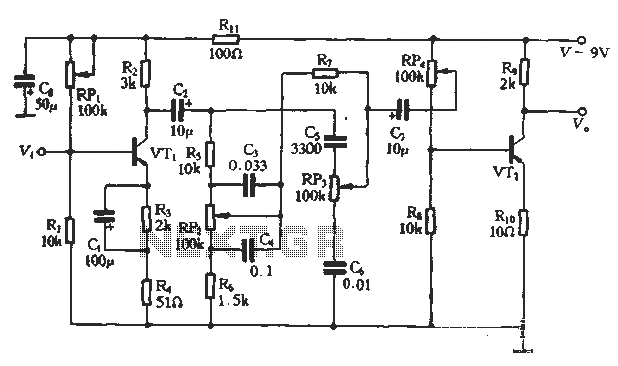
Recording level display circuit
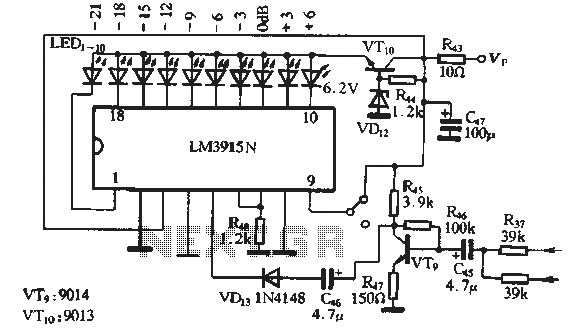
The circuit features a manual recording level control function. When in recording mode, the recording level is indicated by the LM3915N. The sound recording circuit, as illustrated in Figure 3-17, employs an RC network and an associated audio recording preamplifier circuit. Playback features include a common equalization circuit, compatible with chromium (Cr02) and metal (Met) tapes, utilizing three distinct tape playback equalization networks, which are controlled by switch IC2a. The playback voltage amplifier adapts to the input amplifier circuit requirements. IC2b and its related recording equalization network are designed for standard tape, with C12 comprising a low-frequency compensation network, while high-frequency compensation is achieved through R19, C13, and Q4 for chromium and metal bands. High-frequency compensation for the chrome band is provided by C15, C16, and R21, while C17 and C18 form a high-frequency compensation network for the metal band. A potentiometer, RP3, is included for manual adjustment of the recording level. The high-frequency transformer T, along with VTi and VT2, forms a push-pull high-frequency magnetic bias oscillation circuit, oscillating at a frequency of 90 kHz. This bias magnetic oscillator supplies the erase head with bias current and provides bias current for the audio recording heads. To ensure the stability of the bias magnetic oscillation frequency, the power supply for this circuit utilizes an LC filter. The partial magnetic resonance oscillation circuit is shared with the chrome and metal tape selector switch, enabling the provision of different oscillating currents.
The circuit is designed to facilitate the recording and playback of audio signals with precision and flexibility. The LM3915N serves as a visual indicator, providing real-time feedback on the recording level, which is crucial for achieving optimal audio quality. The RC network, in conjunction with the audio recording preamplifier, helps to prepare the audio signal for processing, ensuring that it is appropriately amplified before being recorded.
During playback, the equalization circuit plays a vital role in adapting the output signal to match the characteristics of the tape used. The three distinct equalization settings cater to different tape formulations—chromium and metal—allowing for tailored playback that compensates for frequency response variations inherent to each tape type. The switch IC2a enables seamless transitions between these settings, enhancing user convenience.
The recording equalization network, utilizing components such as C12, R19, C13, and Q4, ensures that both low and high frequencies are accurately represented in the recorded signal. This is essential for maintaining audio fidelity and ensuring that the playback sound matches the original recording as closely as possible.
The inclusion of manual control via potentiometer RP3 allows the user to fine-tune the recording level, providing additional control over the audio input. This feature is particularly beneficial in environments where varying sound levels are present, enabling the user to adjust the recording level to prevent distortion or loss of detail in the audio.
The push-pull high-frequency magnetic bias oscillation circuit, operating at a frequency of 90 kHz, is critical for both erasing previous recordings and ensuring that new audio signals are recorded with clarity. The LC filter used in the power supply for this circuit helps to stabilize the oscillation frequency, which is vital for consistent performance across different recording sessions.
Overall, this circuit design integrates various components and features to enhance the recording and playback experience, providing flexibility, precision, and adaptability to different tape types and recording environments.Provided only manual recording level control function, when the circuit is in the recording mode, the recording level as LM3915N was shown. 3-180 as shown in Figure 3-17 in the sound recording circuit by IC] RC network and related audio recording preamplifier circuit. In playback features common with (NOr) equalization circuit, with chromium (Cr02) and metal (Met) with three different tape playback equalization network network, controlled by switch o IC2a etc.
playback voltage amplifier , to adapt the level of the input amplifier circuit requirements. IC2b and related network of recording equalization network, for ordinary tape and C12 composed by the R17RisCl1 low frequency compensation network, high-frequency compensation by R19, , Cl3, q4 composition o for chromium metal band and high frequency band, is only for compensation, C15 -, C16 and R2l composed of high-frequency compensation chrome band, C17.CIS Biao and high compensation network consisting of a metal band. RP3 potentiometer to manually adjust the recording level. High-frequency transformer T and VTi, VTz composed push-pull high frequency magnetic bias oscillation circuit, the oscillation frequency is 90kHz ;.
The bias magnetic oscillator on the one hand to provide the erase erase head bias current, the other for audio recording heads for sound recording bias current. In order to ensure the stability of the oscillation frequency of the bias magnet, power supply magnetic bias oscillation circuit using an LC filter o Partial magnetic resonance oscillation circuit in common with the same set, chrome belt, metal band selector switch, to provide different oscillating current o
The circuit is designed to facilitate the recording and playback of audio signals with precision and flexibility. The LM3915N serves as a visual indicator, providing real-time feedback on the recording level, which is crucial for achieving optimal audio quality. The RC network, in conjunction with the audio recording preamplifier, helps to prepare the audio signal for processing, ensuring that it is appropriately amplified before being recorded.
During playback, the equalization circuit plays a vital role in adapting the output signal to match the characteristics of the tape used. The three distinct equalization settings cater to different tape formulations—chromium and metal—allowing for tailored playback that compensates for frequency response variations inherent to each tape type. The switch IC2a enables seamless transitions between these settings, enhancing user convenience.
The recording equalization network, utilizing components such as C12, R19, C13, and Q4, ensures that both low and high frequencies are accurately represented in the recorded signal. This is essential for maintaining audio fidelity and ensuring that the playback sound matches the original recording as closely as possible.
The inclusion of manual control via potentiometer RP3 allows the user to fine-tune the recording level, providing additional control over the audio input. This feature is particularly beneficial in environments where varying sound levels are present, enabling the user to adjust the recording level to prevent distortion or loss of detail in the audio.
The push-pull high-frequency magnetic bias oscillation circuit, operating at a frequency of 90 kHz, is critical for both erasing previous recordings and ensuring that new audio signals are recorded with clarity. The LC filter used in the power supply for this circuit helps to stabilize the oscillation frequency, which is vital for consistent performance across different recording sessions.
Overall, this circuit design integrates various components and features to enhance the recording and playback experience, providing flexibility, precision, and adaptability to different tape types and recording environments.Provided only manual recording level control function, when the circuit is in the recording mode, the recording level as LM3915N was shown. 3-180 as shown in Figure 3-17 in the sound recording circuit by IC] RC network and related audio recording preamplifier circuit. In playback features common with (NOr) equalization circuit, with chromium (Cr02) and metal (Met) with three different tape playback equalization network network, controlled by switch o IC2a etc.
playback voltage amplifier , to adapt the level of the input amplifier circuit requirements. IC2b and related network of recording equalization network, for ordinary tape and C12 composed by the R17RisCl1 low frequency compensation network, high-frequency compensation by R19, , Cl3, q4 composition o for chromium metal band and high frequency band, is only for compensation, C15 -, C16 and R2l composed of high-frequency compensation chrome band, C17.CIS Biao and high compensation network consisting of a metal band. RP3 potentiometer to manually adjust the recording level. High-frequency transformer T and VTi, VTz composed push-pull high frequency magnetic bias oscillation circuit, the oscillation frequency is 90kHz ;.
The bias magnetic oscillator on the one hand to provide the erase erase head bias current, the other for audio recording heads for sound recording bias current. In order to ensure the stability of the oscillation frequency of the bias magnet, power supply magnetic bias oscillation circuit using an LC filter o Partial magnetic resonance oscillation circuit in common with the same set, chrome belt, metal band selector switch, to provide different oscillating current o
Warning: include(partials/cookie-banner.php): Failed to open stream: Permission denied in /var/www/html/nextgr/view-circuit.php on line 713
Warning: include(): Failed opening 'partials/cookie-banner.php' for inclusion (include_path='.:/usr/share/php') in /var/www/html/nextgr/view-circuit.php on line 713
